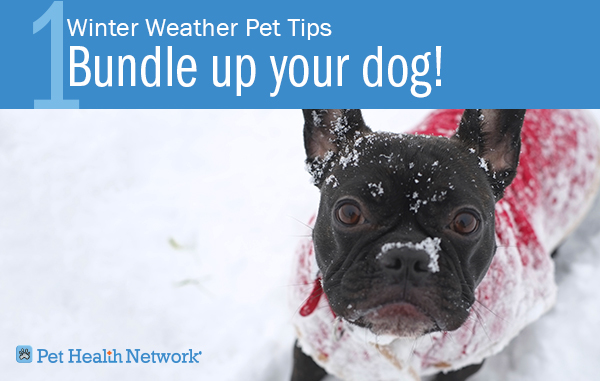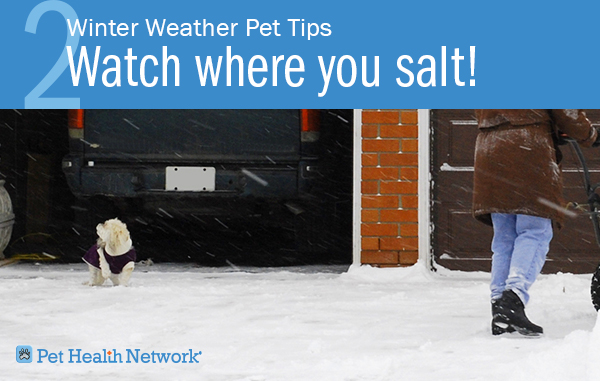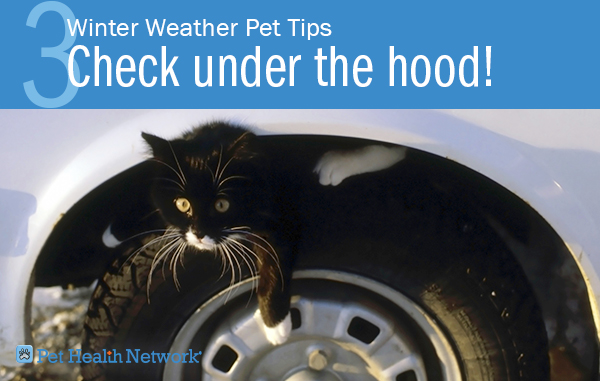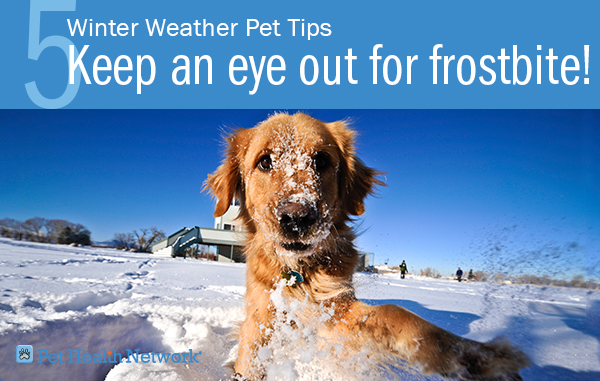As winter approaches, we want to make sure our four-legged friends are safe from the elements. After all, people can bundle up, but our pets can’t add extra layers on a whim. As I’m based out of Minnesota (where it’s winter 6 months out of the year), I know how severe cold injuries can be to pets. Here are some cold weather tips that I hope you will utilize to protect dogs and cats this winter:
1. Bundle up your dog
If your dog doesn’t have a thick, plush hair coat consider a winter jacket when temperatures drop below 20°F. Make sure the jacket is snug and that your male dog doesn’t urinate on the bottom belly strap (which can then worsen frostbite or cold injury).
[Don't miss this video about dogs in sweaters.]

2. Watch where you salt
While ice salt is only mildly poisonous to dogs, it can cause irritation to the skin, paws, and gastrointestinal tract when directly ingested. Make sure to use pet-friendly ice melts (which don’t contain salt). More importantly, since you don’t know what your neighbors have put down, make sure to use a damp cloth to wipe off your pet’s paws after coming into the house.
[Check out the top 10 canine toxins.]

3. Check under the hood
There are a myriad of reasons why it’s advisable to keep your cat indoors at all times. Still, even if you know your cat is in the house, make sure to bang on your car hood before starting the car (this is particularly important if you see paw prints on your hood). Stray cats often hide under a vehicle’s hood when it’s warm and can develop severe fan belt injuries (including broken jaw bones, severe lacerations, etc.) when the car is started.
[Read about Fanny Mea’s encounter with a car engine.]

4. Avoid space heaters
Avoid the use of space heaters, and other sources of external heat, due to the potential for carbon monoxide poisoning, accidental fire, or thermal injury to your pet.

5. Keep an eye out for frostbite
20 minute walks outside are unlikely to result in a problem, but if you take your dog skijoring (skiing behind your dog) or running for prolonged hours at a time when it's less than 20 degrees Farenheit or with a significant wind chill, ice crystals can develop in peripheral tissues (like the ears, prepuce, vulva, tail tip, and toes). Keep a careful eye out for the following signs:
- Redness
- Coolness to touch
- Swelling
- Eventual sloughing of the tissue
If you do notice any signs of frost-nip (the stage immediately before frostbite) or frostbite, make sure to bring your pet into a sheltered, warm area immediately. Most importantly, avoid touching or actively heating the area aggressively; rather, slow re-warming of the tissue with lukewarm water is best. This will prevent further injury with rapid thawing of the ice crystals in the tissue. Do not rewarm the area until it can be kept warm. Warming and then re-exposing the frostbitten area to cold air can cause worse damage. If no water is nearby, breathe on the area through cupped hands and hold it next to your body. Seek immediate attention from your veterinarian to make sure pain medication, salves, or antibiotics aren’t necessary. Keep in mind that once tissue has undergone frostbite, that tissue is more susceptible in the future.
[Next, check out 'Ticks, Dogs and Winter Weather: The Danger is Still Here.']

If you have any questions or concerns, you should always visit or call your veterinarian – they are your best resource to ensure the health and well-being of your pets.
